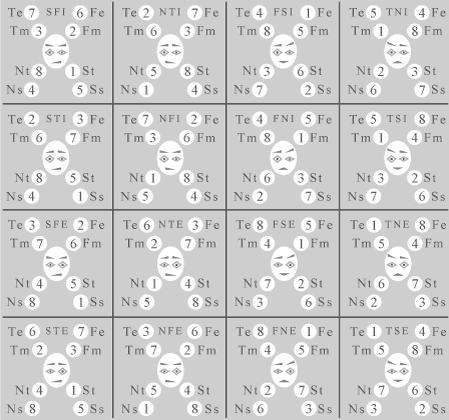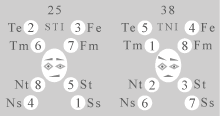-
According to physiognomic parameters of eyebrows and corners of a mouth it is
possible to see projections of hemispheres of a brain and four mental functions
which are a basis of 16 functional types of a human personality, and
physiognomic parameters of eyes in addition allow to see attributes of
introversion and extraversion, that in aggregate with mental functions allows to
identify 64 psychological types of analytical physiognomy, and also
psychological types in a context of Yung's analytical psychology and
Myers-Briggs Type Indicator.
Four mental functions in structure of a human personality have different
positions, namely are leading or minor that forms constructive charts of
psychological types, and in aggregate mental functions with attributes of
introversion and extraversion are shown as realized and not realized (latent)
that also forms designs of psychological types, as shown in the chart.
 |
Numbers in the shown chart designate leading and minor
mental functions. 1 - leading strong function. 2 - second actual function. 3 - third weak function. 4 - fourth non-actual function. 5 - fifth latent strong function. 6 - sixth latent actual function. 7 - seventh latent weak function. 8 - eighth latent non-actual function. Latent not realized functions correlate with realized, namely 1-5, 2-6, 3-7, 4-8 mental functions are correlating and possess similar values, but realized functions are shown as controllable, and latent functions are not supervised by consciousness. The detailed information on latent mental functions of consciousness in a context of analytical psychology look on pages of other website: www.numeralgame.64g.ru/annum/annum6en.htm. |
-
Letters in the shown chart designate psychological types.
STI - sensory-logic introverted.
STE - sensory-logic extraverted.
TNI - logic-intuitive introverted.
TNE - logic-intuitive extraverted.
TSI - logic-sensory introverted.
TSE - logic-sensory extraverted.
NTI - intuitive-logic introverted.
NTE - intuitive-logic extraverted.
NFI - intuitive-ethical introverted.
NFE - intuitive-ethical extraverted.
FSI - ethical-sensory introverted.
FSE - ethical-sensory extraverted.
FNI - ethical-intuitive introverted.
FNE - ethical-intuitive extraverted.
SFI - sensory-ethical introverted.
SFE - sensory-ethical extraverted.
And also letters in the shown chart designate mental functions.
Ss - sensorics of spaces;
Ns - intuition of space;
St - sensorics of time;
Nt - intuition of time;
Fe - ethics of energy;
Te - logics of energy;
Fm - ethics of matter;
Nm - logics of matter.
The detailed information on parities of mental functions of a personality
with categories of space, time, matter, energy look on pages of website:
www.numeralgame.64g.ru/annum/annum3en.htm.
Parities of mental functions with categories of space, time, matter, energy are
connected with attributes of introversion and extraversion, and accordingly
connected with physiognomic parameters of eyes in view of analytical
physiognomy. Namely people perceive space and time by means of sensorics or
intuitions, and also perceive a matter and energy by means of logics or ethics
in interrelations with attributes of introversion and extraversion, that defines
displays of mental functions as realized or latent.
In essence according to physiognomic parameters of eyes and attributes of
introversion and extraversion it is possible to identify 8 positions of mental
functions in structure of a human personality, that allows to analyze mutual
relations of people by means of constructive charts of psychological types in
which interrelations not only realized but also latent mental functions of a
human personality are considered.
For example, mutual relations of people whose facial features are comparable to
25th and 38th psychological types of analytical physiognomy.
 |
25th psychological type is shown as sensory-logic introverted. 38th psychological type is shown as logic-intuitive introverted. Both of psychological type possess attributes active introversion, namely the right eye seems more appreciable rather than the left eye. |
The first strong function of 25th type coincides with the seventh weak
latent function of 38th type that causes contradictions in mutual relations,
namely 38th type is incompetent in spheres of a life where 25th type is
competent. But 38th type does not realize own incompetence as the seventh weak
function is latent that can cause not realized contradictions.
The first strong function of 38th type coincides with the sixth actual
latent function of 25th type that does not cause contradictions as 38th type
realizes own competence of that area where 25th type carries out not realized
competent actions.
It is similarly necessary to analyze concurrences of other mental functions that
allows to speak about human mutual relations.
The following page speaks about transactions and interrelations of mental functions according to parities with categories of space, time, matter, energy.
-